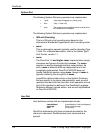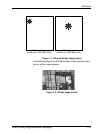
PostScript
1-14 Guide to Using Page Description Languages
Figure 1-3. 600 dpi image output
To preserve image quality when printing on 300 dpi printers,
regenerate the bitmaps at 300 dpi. The 600 dpi printers can
accept jobs with resources in either 300 or 600 dpi. See
“Maintaining image quality” in the “PCL5e” chapter for
information about the recommended attribute settings to use
when generating a document on your system.
Some manufacturers have added hardware imaging
enhancements to 300 by 300 dpi printers that effectively boost
the apparent dpi by micro-controlling the laser beam. The
function is called post-enhancement because it is performed by
the hardware after the PostScript interpreter has imaged into the
frame buffer. The frame buffer is still only 300 by 300 dpi, but the
hardware is controlling the laser beam to produce smoother
edges.
Other manufacturers have added pre-enhancements that involve
the PostScript interpreter. In these printers, the frame buffer is
actually larger because the PostScript interpreter is effectively
rendering at a higher resolution. The hardware performs some of
the halftoning function to provide finer halftoning, resulting in
picture output that looks smoother.
You can only accurately compare two different printers if both are
using the same enhancement techniques or if all enhancement
techniques are turned off.
Printer imaging characteristics
Most xerographic printers do not image perfect circular dots with
even dry ink distribution. The dry ink “spread” is typically
Gaussian, with dry ink density being the greatest at the center of
the dot and fading off toward the edges.


















